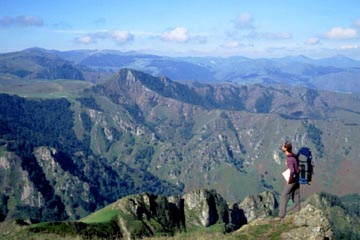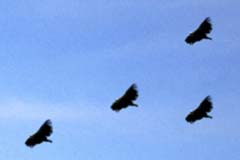In detail ...
We awoke to a most significant change in temperature, a heavy dew decked the grass and we had been cold in our bags, rolling together for warmth; not a morning to linger. We packed more quickly than usual and psyched ourselves for the steep ascent; this would at least warm us up before we escaped the morning's cold shadows. Yesterday's misfortune at finding the refuge closed now gave us a 50m advantage on the ascent, but the tent outer was ringing wet, adding weight to my shoulders. Micro navigation along sheep-tracks taking shoulders and ramps lead us zig-zag fashion towards our goal, and we topped out on Sommet d'Occabe (1466m) after 1+½hr to search for a breakfast spot in the sun.
The waiting company shifted uneasily as we passed; a dozen vultures perched immobile on the rocky outcrops, waiting for the day to warm up. A stiff breeze banished us to shelter behind a rocky tor, where the sun's warmth gave just enough comfort to eat our bread, apple and prunes. From time to time, we peaked into the cold wind to spy out the route ahead; a series of peaks which form the watershed to the upper Irati river. Then on departing the summet, we joined the GR10 for a brief stretch before locating the spur which would take us down 300m to Col de Sourzay. The way led through the Forêt d'Irati, one of europe's largest beechwoods; the trees seemed to be doing well even at 1400m.
The Crane
French: 'Grue cendrée'. These large strangers from the plain and marshland match the vulture in wingspan but their trailing legs and long neck will easily tell them apart; storks are also willing flappers. Their migration from scandinavia breaks at a select location in the Champagne region before appearing at height as they cross the Pyrenees to arrive at destinations in Spain and North Africa. In passage, they fly in jabbering formation reminiscent of geese, a symbol of the changing season to many who watch. The French
cendrée (ashen) refers to the grey plumage.
After crossing a road, a better path led us in ascent once more, to a balcony traverse of Saroberry mountain, where the shattered schists had left an impressive jagged spine plunging northwest into the valley. This precipitous outlook felt almost aerial, prompting an exclamation; 'Oh for the wings of a dove!' Or even, a
crane! High above us six early long-necked migrants flapped southwards on their way to warmer lands. Just ahead, we crossed another, busier road at Col de Burdincurutcheta (1135m) which stands just above the source of the river Irati; unusually, the frontier lies south of here, so that this Spanish river rises in France.
On the flanks of Pic Mendibel the gap between Karen and I stretched a little too much and after catching up, she gave me an earful. I had been out of view chasing a series of discontinuous beast 'trods', so how could she possibly know which choices I had made? Energy and morale were flagging so we decided on an imminent lunch stop. We found the right spot just above a wood and below some bluffs of pleasing pudding-stone, but right on the path. We felt a bit guilty about monopolising it, but need not have worried, not a soul came by. More tapioca and prunes, and on only the second occasion, this menu was already losing favour. We both agreed we'd rather eat rice or pasta than this sticky paste.
The path resumed, we came to some dramatic terrain having switched to a North side traverse approaching Pic des Escaliers.
Karen_comments
A path led first through a wood (where we disputed the several levels available), then exited onto a steep eroded slope above jagged cliffs and pinnacles. It was not hard to imagine that a slip here might not easily be arrested; Karen was vexed. 'This can't be the right way', she said.
'I don't think there
is a right way'. I replied
'But why did you choose such a steep path, this must be dangerous!'
'Well, that may be so, but we're sure to encounter more and harder terrain in the bigger mountains. Today the weather and visibility is good, so why not just take it as a valuable training exercise? You have those two extra 'legs' to help as well', I said in reference to her trekking poles. We continued in grim silence and it was all over soon enough on gaining the broader hill-top.
Karen_comments
The descent brought us to a col where a few motorists lingered, and I chatted to a French woman; she had worked for a shipping company in Fleetwood, where I had once lived as a boy. We almost gave in to her kind offer to relieve us of our packs for the unwanted re-ascent on tarmac, but honour prevailed. The last hill of the day was inevitably tedious, but at last, we arrived at the Chalet d'Irati holiday complex of Col Bagargiak where we booked into the
gite d'étape and discovered the shop. Only eight days into the trek and we were already becoming obsessive over food, and in grave danger of over-stocking; apples, peppers, prunes, raisins, lentils, tabouleh, macaroni, sardines
must eat one of the three-pack tonight over ripe
prix-reduit bananas, and poor long-life white bread all went into the basket. 'Blame the tapioca' I said; we were making up for mis-spent appetite!
Karen had her own affairs to manage for a while, so I ambled down the road a little to discover a significant ornithological feature. Only 500m away the road passes by Col d'Orgidambexka (1284m), famous for its wrangling between the bird lovers of the League Protection d'Oiseau and the
chasseurs of migrant birds
I mean wood-pigeons ... No strife today, but the twitchers were out with their telescopes and binoculars and there was plenty to see; vultures and other raptors cruising by. Being a significant low point in the surrounding forest, many migrant birds favour passage here.
Back at the comfy wooden 'A'-frame chalet we feasted and then went to visit the Swiss who had turned up shortly after us. We found them in their hostel, Madame the worse for wear; she was hobbling terribly from a sore foot and we were incredulous to know that she expected to resume course on the morrow. They gave us a compelling insight into an option in the route ahead; a section of the limestone Karstic country which presents itself as magical and tortured, a maze of tottering valleys and pinnacles. I frowned and tried hard to visualise. What I saw was a maze of smooth rocks with a small but obvious path winding through; the vision was bare of vegetation, or at least trees. Of course I was drawn to this challenge, but reality proved just how naive my mental picture had been. Karen and I continued to wrangle over this fascinating option during the next couple of days, but fate had us signed up already; the awful alternative was a trudge of many hours on tarmac.


